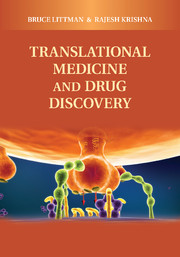Book contents
- Frontmatter
- Contents
- Contributors
- Preface
- Translational Medicine and Drug Discovery
- SECTION I TRANSLATIONAL MEDICINE: HISTORY, PRINCIPLES, AND APPLICATION IN DRUG DEVELOPMENT
- 1 TRANSLATIONAL MEDICINE: DEFINITION, HISTORY, AND STRATEGIES
- 2 TRANSLATIONAL MEDICINE AND ITS IMPACT ON DIABETES DRUG DEVELOPMENT
- 3 CHALLENGES IN ATHEROSCLEROSIS
- 4 OBESITY: NEW MECHANISMS AND TRANSLATIONAL PARADIGMS
- 5 BONE DISORDERS: TRANSLATIONAL MEDICINE CASE STUDIES
- 6 CASE STUDIES IN NEUROSCIENCE: UNIQUE CHALLENGES AND EXAMPLES
- 7 TRANSLATIONAL MEDICINE IN ONCOLOGY
- SECTION II BIOMARKERS AND PUBLIC–PRIVATE PARTNERSHIPS
- SECTION III FUTURE DIRECTIONS
- Index
- References
7 - TRANSLATIONAL MEDICINE IN ONCOLOGY
Published online by Cambridge University Press: 04 April 2011
- Frontmatter
- Contents
- Contributors
- Preface
- Translational Medicine and Drug Discovery
- SECTION I TRANSLATIONAL MEDICINE: HISTORY, PRINCIPLES, AND APPLICATION IN DRUG DEVELOPMENT
- 1 TRANSLATIONAL MEDICINE: DEFINITION, HISTORY, AND STRATEGIES
- 2 TRANSLATIONAL MEDICINE AND ITS IMPACT ON DIABETES DRUG DEVELOPMENT
- 3 CHALLENGES IN ATHEROSCLEROSIS
- 4 OBESITY: NEW MECHANISMS AND TRANSLATIONAL PARADIGMS
- 5 BONE DISORDERS: TRANSLATIONAL MEDICINE CASE STUDIES
- 6 CASE STUDIES IN NEUROSCIENCE: UNIQUE CHALLENGES AND EXAMPLES
- 7 TRANSLATIONAL MEDICINE IN ONCOLOGY
- SECTION II BIOMARKERS AND PUBLIC–PRIVATE PARTNERSHIPS
- SECTION III FUTURE DIRECTIONS
- Index
- References
Summary
Translational medicine (TM) has many definitions in many settings, but a common theme is to take biomedical research from “bench-to- bedside” using various classes of biomarkers to speed drug-development decisions. For a variety of reasons that will be discussed in this chapter, TM and biomarkers have arguably had their greatest impact in the area of oncology. Cancer drug development differs in many ways from drug development in other therapeutic areas, and the use of biomarkers as surrogates for clinical benefit has had a long history in oncology. In this chapter, we will explore the use of various classes of biomarkers in oncologic drug development and establish some general principles and points to consider when using translational approaches to cancer therapeutics.
A biomarker is defined as “a characteristic that is measured and evaluated as an indicator of normal biological processes, pathogenic processes, or pharmacological responses to a therapeutic intervention.” For the purposes of this chapter, three major classes of biomarkers are defined based on how they are used in the development of cancer drugs: pharmacodynamic (PD) biomarkers, outcome biomarkers, and patient selection biomarkers.
Pharmacodynamic Biomarkers
PD biomarkers, sometimes called “target” or “mechanism” biomarkers, are largely concerned with direct biochemical or physiologic effects of drugs on their intended targets (e.g., enzyme inhibition, receptor antagonism) independent of any relationship to potential clinical benefit.
- Type
- Chapter
- Information
- Translational Medicine and Drug Discovery , pp. 180 - 192Publisher: Cambridge University PressPrint publication year: 2011



